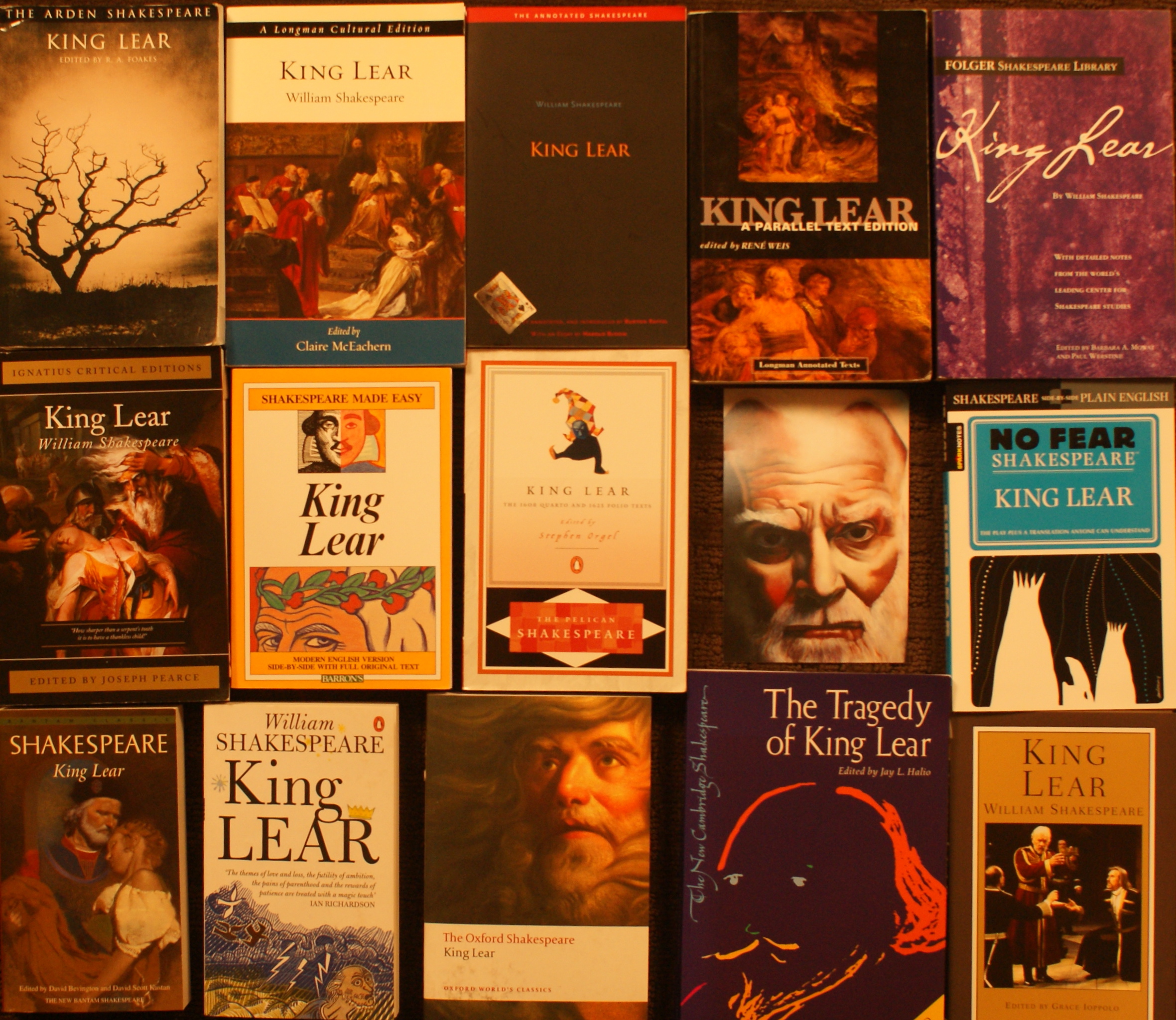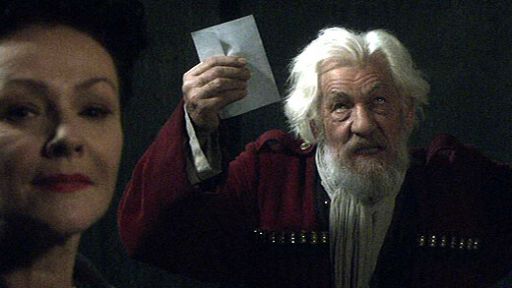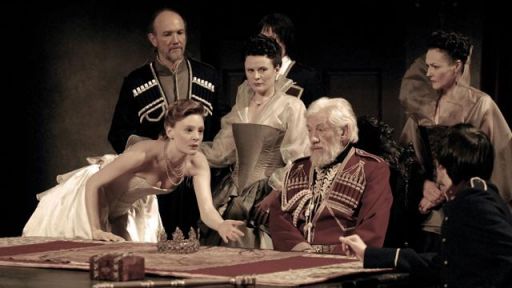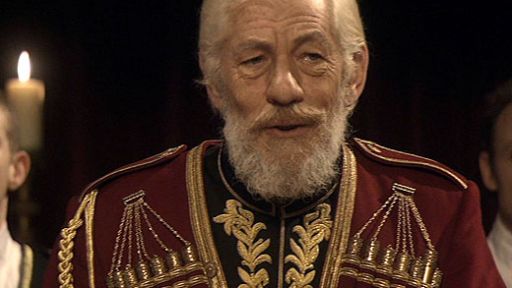
As with most of Shakespeare’s famous plays, King Lear may be found each year in many individual print editions. At least twenty such editions were in print for King Lear as of Spring of 2009. Each attempts to realize some distinction relative to the others. However, it seems useful to separate them into three broad categories: reading editions, with or without modest annotations for difficult words and phrases; academic editions with more significant annotations and a preference for one rather than another relationship to the two source texts; and other versions that might involve animation, prose renditions, or translation into modern English idioms.
The Two Text Problem
We have two somewhat different source texts for King Lear, a Quarto (Q) of 1608 and a Folio of 1623 (F). After a prior judgment that the Q text was “bad,” created perhaps from memory by players, both are now widely considered to be authentically Shakespeare. The Q text gives Albany a stronger character and diminishes Edgar relative to the F text. However, the central editorial issue between them revolves around the trial scene in Act III Scene vi. It is in Q and not in F. Despite its modest (if any) contribution to the play’s dramatic flow, directors want to include it. Indeed, no film version of the play excludes it. Once one element of Q intrudes on F, a relatively large number of others follow (although no one adopts the Q treatment of Albany and Edgar). As a consequence, a common editorial practice, adopted as long ago as 1725, installs parts of Q in F, creating what has become called a “conflation” or “conflated text.” That the level of actual conflation varies from editor to editor, sometimes considerably, does not gainsay this singular appellation.
Some recent academic essays on this subject have howled in protest, arguing that conflation diminishes the dramatic power of the play at key moments and distorts Shakespeare’s “intentions.” The Quarto text was an early effort, whole unto itself, the Folio text a later version, changed in certain ways, but also whole unto itself. Shoving the two together creates some kind of mongrel inferior to both. One may have sympathy for these arguments. However, the cold cruel fact is that conflated texts have dominated the print edition world of King Lear for so long that every film and virtually every staged performance begins with a conflated text, and then cuts lines to find a suitable run time. Most directors do not cut based on where lines came from, but on dramatic grounds. As mentioned, the trial scene seems dear to most. Therefore, anyone interested in the connection between a print edition and a play or film must have at least one conflated text.
Reading Editions
The following editions all provide conflated texts (although the Raffel edition omits the trial scene), some introductory material, and annotations for difficult words or phrases. They are listed in alphabetical order by editor. From a reading point of view, the most important distinction among this group might be the way in which each displays annotations—facing page, at bottom of page, end notes, or on same page in an adjacent column. Some people find facing pages easier than page bottoms for quick reference; other do not. Some even prefer end notes which can be easily accessed with a book mark.
Bevington, David. Bantam Classics (2005). Some Shakespeare sources appended. Annotations on facing page indexed by line number.
Hunter, George. Penguin Books (2005). Introduction by Kiernan Ryan. Annotations in end notes, more ample generally than other reading texts, indexed by line number.
Lamb, Sidney. Wiley Publishing (2000); Cliffs Complete. Study commentary follows each act. Annotations on same page in parallel with text, indexed by line number (pages are larger than other editions).
McEachern, Claire. Pearson Longman (2005). Some short, interesting essays at back from commentators before 20th Century. Annotations in footnotes indexed by line number.
Mowat, Barbara and Westine, Paul. Washington Square Press (2005). From Folger Library. Annotations on facing page indexed by line number.
Raffel, Burton. Yale University Press (2007). Afterword by Harold Bloom. Annotations in small footnotes indexed by footnote numbers in text.
Academic Editions
“Academic” does not mean here that the text is more obscure or the commentary more abstruse or the editor more prestigious. It simply means either that the edition does not supply a conflated text (and hence serves less well when studying films or staged performances of the play) or its annotations and supplemental material engage issues that fit within the compass of literary criticism rather than, or in addition to, popular criticism. They tend to be more expensive, but no Lear text in paperback will threaten even today’s shrinking bank balances.
Foakes, R. A. Arden Shakespeare (2007). Conflated text with the best footnotes. Strong but at times confusing introduction. Probably the classic academic text.
Halio, Jay. Cambridge University Press (2005). Main text Folio only. Quarto additions in an appendix. Heavily and well annotated. Strong historical introduction.
Holderness, Graham. Prentice Hall (1995). Raw Quarto text without annotations. Minimal modernization of spelling and punctuation. Therefore closest to the original text of any Quarto edition. Introduction devoted principally to the Quarto/Folio text question.
Ioppolo, Grace. Norton and Company (2008). Footnotes between reading and academic level. What distinguishes the Norton (generally) is a large body of critical writing, beyond any other text.
Orgel, Stephen. Penguin Books (Pelican Shakespeare) (2000). Separate printing of Quarto and Folio texts, with modernized spelling and punctuation. No conflated text. Footnotes at level of reading text. Short but highly sensible analysis of the play in Introduction.
Pearce, Joseph. Ignatius Press (2008). Footnotes at level of reading text. Introduction ably defends play as Christian. Appendices offer two canonical and some new critical essays. Includes ratings and reviews of six films that differ from reviews offered by guest contributor to this site.
Weis, Rene. Longman (1993). Printing of Folio and Quarto texts on facing pages, to see differences visually (but very frustrating to read). Strong footnotes.
Wells, Stanley. Oxford University Press (2008). Quarto text divided in original twenty-four scenes, but modernized spelling and punctuation. Strong historical introduction with emphasis on performance questions. Strong footnotes, comparable to Arden.
Others
King Lear has attracted a variety of alternative expressions, either translations into contemporary English, cartoons, or the form of a prose novel.
Crowther, John. Sparkenotes (2003). No Fear Shakespeare. The full Shakespeare text on the verso page, a modern translation on the recto page. There is no effort to realize the modern in poetry.
Durband, Alan. Barrons (1986). Shakespeare Made Easy. The full Shakespeare text on the verso page, a modern translation on the recto page. The poetry of the modernized version is painful, but it can be understood. Perhaps best read to realize how good Shakespeare really was.
Gill, Roma. Oxford University Press (2002). A reading text intended for students (it could have as easily been placed in the first category).
Hutchinson, Emily. Saddleback Publishing (2006). A modern translation without facing page original. It is also radically cut.
Illidge, Paul. Creber Monde Entier (2006). A prose version of the play in novel form. Generally holding to the original, with much of Shakespeare’s dialogue retained. However, . . .
Metzger, Sheri. CliffNotes (2000). Not a Lear text per se, but a common study guide. It is filled with mistakes, misunderstandings, and imaginative interpolations of the play.
Pollock, Ian. Black Dog and Levinthal (1984). A cartoon version of the play with the full play text as script.





